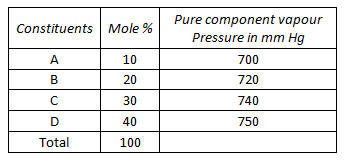Chemical Engineering :: Petroleum Refinery Engineering
-
Which of the following gasolines (unleaded) has the least octane number ?
-
Feed for reforming is generally
-
A fuel oil consists of 4 fractions A, B, C and D. Their molar compositions and vapour pressures are given below :

The vapour pressure of the fuel oil will be __________ mm Hg. -
Which of the following is the most important property for a jet fuel ?
-
Which parameter is used for the grading of paraffin waxes ?
-
Which of the following has the minimum °API gravity of all?
-
Higher pressure in the reforming reactor
-
Gasoline yield in catalytic reforming of naphtha may be about __________ percent by weight.
-
The main reaction in reforming is the


 Whatsapp
Whatsapp
 Facebook
Facebook

